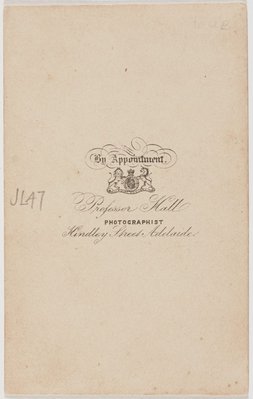-
Details
- Date
- 1855-1865
- Media category
- Photograph
- Materials used
- carte de visit
- Dimensions
- 5.3 x 4.1 cm oval image; 10.4 x 6.5 cm sheet; 10.4 x 6.5 cm mount card
- Signature & date
Not signed. Not dated.
- Credit
- Gift of Josef & Jeanne Lebovic, Sydney 2014
- Location
- Not on display
- Accession number
- 582.2014
- Copyright
- Artist information
-
Professor Robert Hall
Works in the collection
- Share
-
-
About
Robert Hall was an ornithologist, publican, and photographer. He was in Adelaide by 1842, and from 1842 to 1846 he worked as an ornithologist until becoming an agent for the newly-arrived German photographer Edward Schohl. In 1846 he began advertising his services as a daguerreotypist, with rather mixed results. In the same year he visited Perth and Fremantle, where he took that colony’s first recorded photographs. From 1846 to 1854 Hall worked on and off as a photographer dividing his time between photography and the boarding house he opened in 1848. After a return trip to England in 1854 he began to style himself as ‘Professor Hall’, making portraits and views of local scenery, in daguerreotype, calotype, ambrotype, albumen and collodion processes, as well as painted photographs. In 1854 he advertised stereographic views, the first photographer to do so in South Australia. In 1861 he showed the first specimens of the new carte de visite format seen in Adelaide. Hall retired in 1865 to become landlord of the Gresham Hotel and died in Adelaide in 1866. He was remembered in the Southern Argus of 1 September 1866 as an ‘honest and kindly-hearted, if somewhat erratic citizen’.
A carte de visite is a stiff card of about 10 x 6.4 cm, with an attached paper photograph, invented in 1854 by André-Adolphe-Eugène Disderi. They were introduced into Australia in 1859 by William Blackwood with albums arriving in 1860, aiding the collection and distribution of multiple cartes. Cartes were usually portraits and were made by the millions worldwide. Multi-lens, or ‘multiplying’ cameras were introduced in the 1860s, which were capable of producing from 2 to 32 images in quick succession, dramatically increasing the number of cartes de visite that could be made from a single photographic plate. They were easily reproduced by making paper contact prints from the glass plates, which were then cut and pasted to card.
-
Exhibition history
Shown in 1 exhibition
The photograph and Australia, Art Gallery of New South Wales, Sydney, 21 Mar 2015–08 Jun 2015
The photograph and Australia, Queensland Art Gallery, South Brisbane, 04 Jul 2015–11 Oct 2015
-
Bibliography
Referenced in 1 publication
-
Judy Annear, The photograph and Australia, Sydney, Jun 2015, 238 (colour illus.).
-

